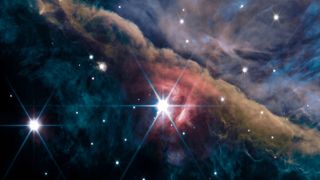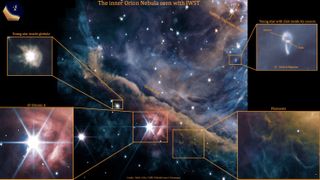New James Webb telescope images reveal the chaotic beauty of Orion's sword
One of the brightest, closest nebulas to Earth just got its clearest close-up ever.

How do you know you're looking at Orion's belt? It's just a waist of space.
Dad jokes aside, Orion is one of the best known and most studied constellations in the Milky Way. With its nearest stars located just a few hundred light-years from Earth, the constellation is home to some of the largest and brightest stars in the sky (including the infamous red star Betelgeuse) and a thriving nursery of fiery, newborn stars ripe for studying.
Now, using the powerful new James Webb Space Telescope (JWST), researchers have captured the sharpest and most detailed images of Orion in history.
The images, shared Monday (Sept. 12) in a statement, do not include the infamous triple-star "belt" of Orion, but rather focus on Orion's gassy "sword" hanging just to the south. At the center of the sword lies the Orion Nebula — one of the biggest and brightest star-forming regions close to Earth.

Visible to the naked eye from our planet, the Orion Nebula has for centuries been a popular target for stargazers — including Italian astronomer Galileo Galilei, who is credited with discovering the nebula's largest star cluster, called the Trapezium, more than 400 years ago. Now, the new JWST images zoom in on the heart of the nebula like never before, revealing shifting sculptures of star-forming gas being whipped into shape by powerful stellar radiation.
"Massive young stars emit large quantities of ultraviolet radiation directly into the cloud that still surrounds them, and this changes the physical shape of the cloud as well as its chemical makeup," Els Peeters, an astronomy professor at Western University in Ontario, Canada, said in a statement. "These new observations allow us to better understand how massive stars transform the gas and dust cloud in which they are born."
Shining at the image's center is the bright star omicron 2 Orionis A, located about 186 light-years from Earth. The Nebula itself sits far behind, roughly 1,350 light-years from Earth, where thousands of young stars illuminate and irradiate the gas clouds around them.
Sign up for the Live Science daily newsletter now
Get the world’s most fascinating discoveries delivered straight to your inbox.
The violent interactions between stars and their home cloud can be seen most clearly in the long, brownish strip of gas located behind the central star. This dense wall of gas is known as the Orion bar, and is slowly being pushed out and eroded away by the intense stellar radiation of the hottest, brightest stars in the Orion Nebula. Sprinkled throughout the bar are an array of spectacular and mysterious features, including long, wispy filaments of hydrogen, young stars surrounded by planet-forming discs of dust, and great globs of gas that are slowly collapsing into baby stars before astronomers' eyes.
Galileo would be impressed.
Originally published on Live Science.

Brandon is the space/physics editor at Live Science. His writing has appeared in The Washington Post, Reader's Digest, CBS.com, the Richard Dawkins Foundation website and other outlets. He holds a bachelor's degree in creative writing from the University of Arizona, with minors in journalism and media arts. He enjoys writing most about space, geoscience and the mysteries of the universe.
